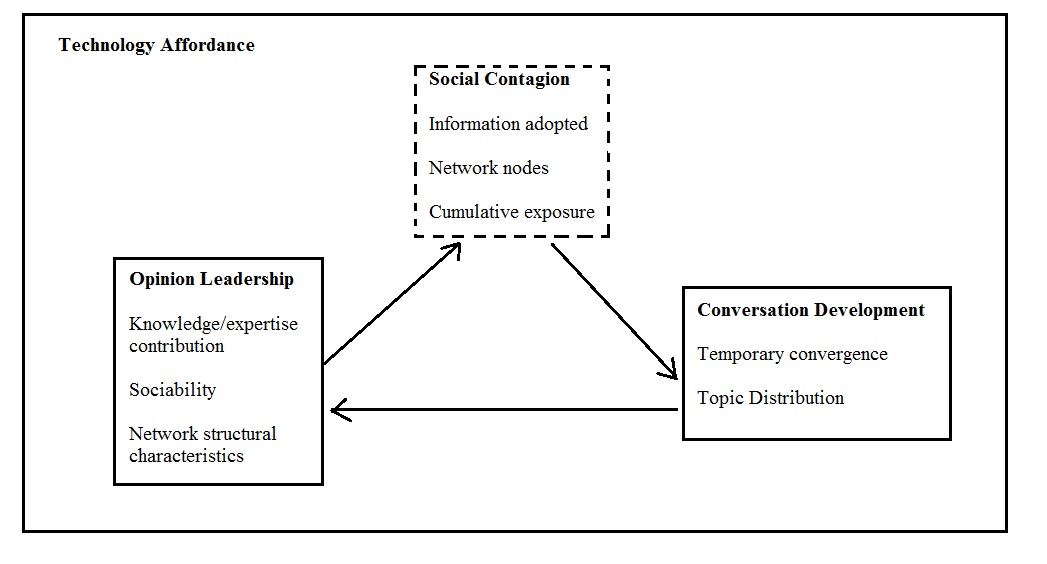#Dynamic interaction between opinion leadership and conversation development in the context of knowledge collaboration in online community
The digital platform has got increasingly involved in people’s daily life. Online community allows the mass public to gather and express their opinions and emotions. It is also not uncommon for people to search for advice or solutions from social networking site. For instance, one can use hashtag plus keywords to look for opinions about certain issues on Twitter (e.g. # howtoloseweight). Zhihu, one of the most popular question-and-answer networking website in China, functioning as an online community for knowledge collaboration (Alexa, 2016; Zhu, 2013). Such prevailing use of cyberspace has exposed massive online activities and led to increasing availability of data for research purpose.
In issues of online community, opinion leadership in cyberspace have already drawn attention from researchers and practitioners especially from marketing and innovation (Aral, 2010). Although recent research has investigated the antecedents of opinion leadership such as indvidual intrinsic characteritics and networking structural characteristics (Lu, Jerath and Singh, 2013), few studies have really looked at dynamic interaction between emergence of opinion leaders and online conversation development (i.e. temporary convergence on certain topics, attitudes towards certain opinions) (Faraj, Jarvenpaa and Mjchrzak, 2011). Moreover, recent research about leadership effects on conversation or collaboration are conducted the laboratory settings (Tost, Gino, and Larrick, 2013).
Hence, this research is proposed to conduct a longitudinal study aimed at establishing an integrative framework of the dynamic interaction between opinion leadership and conversation development. Since knowledge collaboration of the public usually provides rich data of conversation and discussion, the research is proposed to conduct in the context of knowledge collaboration. In this proposed study, I am going to investigate three streams of research questions (See Figure 1 also).
1. How opinion leadership affects convergence/divergence of the conversation?
This refers to how leadership may influence the conversation evolvement through during the social contagion process. This may include both positive effect (concentrate resources on critical threads, encourage active participation), and negative effect (constrain diversified perspectives, control information flow), as well as the impact on distribution of attitudes, sentiments or broad topic development. A specific scenario could be what is the role of opinion leadership in online conflicts?
2. How conversation development affects opinion leadership?
Although several studies have investigated the antecedents of opinion leadership, such leading role can hardly be permanent in fluid online communities (Faraj, Jarvenpaa and Mjchrzak, 2011). Prior studies tend to assume a stable opinion leadership with insufficient attention to how leadership may change as the conversation evolves. Therefore, questions like who tend to maintain their leading role, or under what condition, who turn to be more influential, can be the specific questions.
3. How formal structural mechanism in online communities moderates the aforementioned relationships above?
Leadership in communities with formal structural mechanism which recognizes active participants, offering recommendation, and allowing establishment of formal communities can be different from that in self-organizing communities. The actions of participants are shaped by technological possibilities which may moderate the relationships proposed before.

Conceptual Framework
Data source: in terms of data source and which knowledge collaboration community to study, I plan to use Twitter (e.g. ## digitaltransformation, # howtoloseweight) as the self-organizing community and Zhihu.com (???as the community with formal structural mechanism, as data of both platform can be extracted relatively easily. Social information landscape will be applied to capture the interaction and networking data (Ch’ng, 2015).
Contribution to knowledge and implication
This research may contribute to literatures of leadership by extending the context into a real setting (i.e. on cyberspace), to literatures of open innovation by providing insights about organizational behavior exposed online.
In terms of managerial implication, it can be beneficial for service recovery. When there is a service failure, managers may have certain understanding on how to take actions accordingly to save their brands. It may also give practitioners understandings on how to create an atmosphere for open innovation.
Alexa Internet. (2016). How popular is zhihu.com? [online]. Available from: < http://www.alexa.com/siteinfo/zhihu.com> [Retrieved 2nd March 2016].
Aral, S. (2010). Identifying Social Influence: A Comment on Opinion Leadership and Social Contagion in New Product Diffusion. Marketing Science. Commentary, 1-7
Ch’ng, E (2015). Social Information Landscapes. Industrial Management & Data System. 115 (9). 1724-1751
Faraj, S., Jarvenpaa, S., and Majchrzak, A. (2011). Knowledge Collaboration in Online Communities. Organization Science 22(5). 1224-1239.
Lu, Y., Jerath, K., and Singh, P. (2013). The Emergence of Opinion Leaders in a Networked Online Community: A Dyadic Model with Time Dynamics and a Heuristic for Fast Estimation. Management Science. 1-17
Tost, L.P., Gino, F., and Larrick, R. P. (2013). When power makes others speechless: the negative impact of leader power on team performance. Academy of Management Journal. 56(5), 1465-1486
Zhu, X (2013). "Zhihu has over 10 million monthly active users" (in Chinese). QQ.com. [online]. Available from: <tech.qq.com/a/20130713/006457.htm> [Retrieved 3 February 2016].
This work was carried out at the International Doctoral Innovation Centre (IDIC). The authors acknowledge the financial support from Ningbo Education Bureau, Ningbo Science and Technology Bureau, China's MOST, and the University of Nottingham. The work is also partially supported by EPSRC grant no EP/L015463/1.